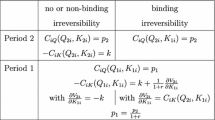Abstract
This paper integrates two themes in the intertemporal permitliterature through the construction of an intertemporal bankingsystem for a pollutant that creates both stock and flow damages. A permit banking system for the special case of a pollutant thatonly causes stock damages is also developed. This latter,simpler case corresponds roughly to the greenhouse gas emissionreduction regime proposed by the U.S. Department of State as ameans of fulfilling the U.S. commitment to the FrameworkConvention on Climate Change. This paper shows that environmentalregulators can achieve the socially optimal level of emissionsand output through time by setting the correct total sum ofallowable emissions, and specifying the correct intertemporaltrading ratio for banking and borrowing. For the case ofgreenhouse gases, we show that the optimal growth rate of permitprices, and therefore the optimal intertemporal trading rate, hasthe closed-form solution equal to the ratio of current marginalstock damages to the discounted future value of marginal stockdamages less the decay rate of emissions in the atmosphere. Given a non-optimal negotiated emission path we then derive apermit banking system that has the potential to lower net socialcosts by adjusting the intertemporal trading ratio taking intoaccount the behavior of private agents. We use a simplenumerical simulation model to illustrate the potential gains fromvarious possible banking systems.
Similar content being viewed by others
REFERENCES
Arrow, K. J., W. R. Cline, K. G. Maler, M. Munasinghe, R. Squitieri and J. E. Stiglitz(1996), ‘Intertemporal Equity, Discounting, and Economic Efficiency’, in J. P. Bruce, H. Lee and E. F. Haites, eds., Climate Change 1995: Economic and Social Dimensions of Climate Change, Contribution of Working Group III to the Second Assessment Report of the IPCC. Cambridge: Cambridge University Press.
Baumol, W. J. and W. E. Oates (1988), The Theory of Environmental Policy, 2nd edn. CambridgeUniversity Press.
Biglaiser, G., J. K. Horowitz and J. Quiggin (1995), ‘Dynamic Pollution Regulation’,Journal of Regulatory Economics 8, 33–44.
Burtraw, D. (1996), ‘Cost Savings Sans AllowanceTrades? Evaluating the SO2 Emission Trading Program to Date’, Resources for the Future, Discussion Paper95-30-REV, February.
Cronshaw, M. B. and J. B. Kruse (1996), ‘Regulated Firms inPollution Permit Markets with Banking’, Journal of Regulatory Economics (March) 9(2), 179–189.
Cropper, M. and W. O. Oates (1992), ‘Environmental Economics: A Survey’, Journal ofEconomic Literature, 675–740.
Energy Information Agency (EIA) (1995), ‘Office of Integrated Analysisand Forecasting, U.S. Department of Energy’, Emissions of Greenhouse Gases in the United States 1987–1994. DOE/EIA – 0573(94), September.
Falk, I. and R. Mendelsohn (1993), ‘The Economics of Controlling Stock Pollutant: An Efficient Strategy for Greenhouse Gases’, Journal of Environmental Economics and Management 25, 76–88.
Hahn, R. W. and R. N. Stavins (1993), ‘Trading in GreenhousePermits: A Critical Examination of Design and Implementation Issues’, in C. William and H. Lee, eds., Paper prepared for Global Climate Policy.
Houghton, J. T. et al. (1996), Climate Change 1995: The Scienceof Climate Change, Contribution of Working Group 1 to the Second Assessment Report of the Intergovernmental Panel on Climate Change. Cambridge: Cambridge University Press.
Jackson, T. (1995), ‘JointImplementation and Cost-Effectiveness Under the Framework Convention on Climate Change’, Energy Policy (November) 23, 117–138.
Kamien, M. I. and N. L. Schwartz (1991), Dynamic Optimization:The Calculus of Variations and Optimal Control in Economics and Management, 2nd edn. New York: Elsevier Science Publishing Co., Inc.
Kling, C. L. and J. Rubin (1997), ‘Bankable Permits for theControl of Environmental Pollution’, Journal of Public Economics (forthcoming).
Kosobud, R. F., T.A. Daly, D.W. South and K. G. Quinn (1994), ‘Tradable Cumulative CO2 Permits and Global Warming Control’, The Energy Journal 15(2), 213–232.
McGartland, A. O. andW. O. Oates (1985),‘Marketable Permits for the Prevention of Environmental Deterioration’, Journal of Environmental Economics and Management 12, 207–228.
Montgomery, W. D. (1972), ‘Markets in Licenses and EfficientPollution Control Programs’, Journal of Economic Theory 5, 395–418.
Nordhaus, W. D. (1996),Managing the Global Commons: The Economics of Climate Change. Cambridge, MA: MIT Press.
Nordhaus, W. D. and Z. Yang (1996), ‘A Regional Dynamic General-Equilibrium Model of AlternativeClimate-Change Strategies’, American Economic Review 84(6), 741–765.
Rubin, J. R. (1996), ‘AModel of Intertemporal Emission Trading, Banking and Borrowing’, Journal of Environmental Economics and Management 31, 269–286.
Swart, R. J. (1993), ‘Climate Targets and Comprehensive GreenhouseGas/Emissions Trading’, Natural Resources Forum 17(1), 43–49.
Trenberth, K. E., ed. (1992),Climate System Modeling. Cambridge: Cambridge University Press.
U.S. Department of State (1997),‘Draft Protocol to the Framework Convention on Climate Change’, as released by the Department of State, Bureau of Oceans and International Environmental and Scientific Affairs, January 28.
U.S. General AccountingOffice (1994), ‘Air Pollution: Allowance Trading Offers an Opportunity to Reduce Emission at Less Cost’, Report to the Chairman, Environment, Energy, and Natural Resources Subcommittee, Committee on Government Operations, House of Representatives, December.
United Nations, Framework Convention onClimate Change, Conference of the Parties (1997), ‘Kyoto Protocol to the United Nations Framework Convention on Climate Change’, Third Session, December 10.
Author information
Authors and Affiliations
Rights and permissions
About this article
Cite this article
Leiby, P., Rubin, J. Intertemporal Permit Trading for the Control of Greenhouse Gas Emissions. Environmental and Resource Economics 19, 229–256 (2001). https://doi.org/10.1023/A:1011124215404
Issue Date:
DOI: https://doi.org/10.1023/A:1011124215404




